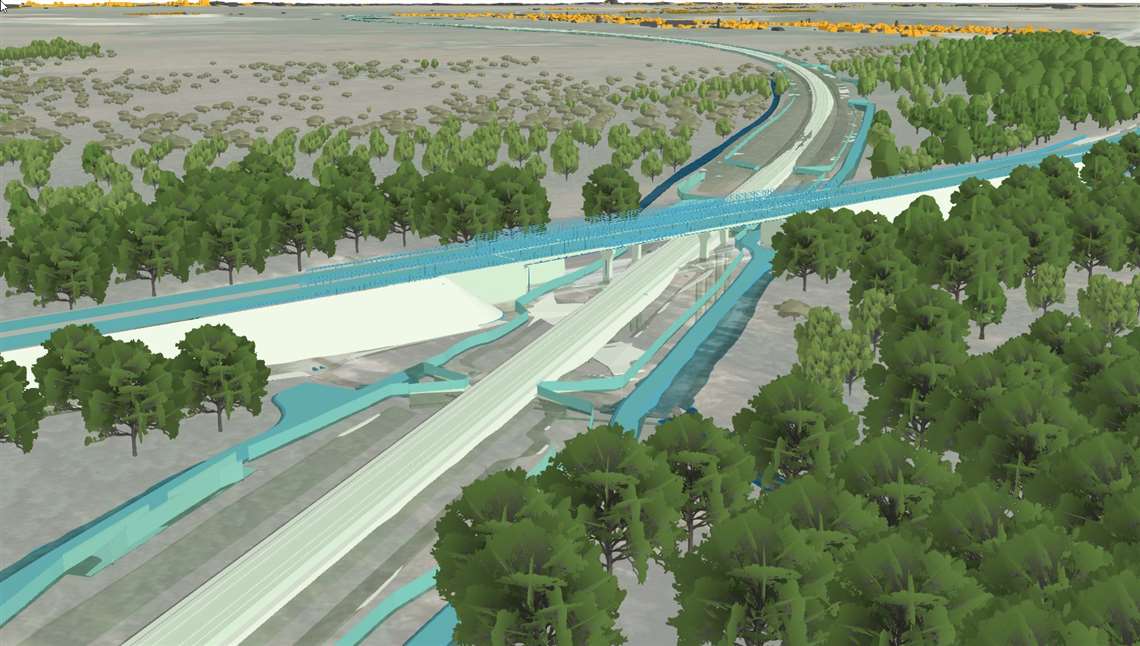How technology is keeping Rail Baltica on track
12 July 2022
Comprising seven international passenger stations, three freight terminals and more than 400 new bridges, the 870km long Rail Baltica, a railway linking the three Baltic states with the rest of Europe promises to be one of the continent’s most complex. Lucy Barnard speaks to RB Rail’s head of virtual design and construction, Raitis Bušmanis, to find out how new technology - and fear of Russian aggression - is helping to keep the project on track
It may be nearly 2,000 kilometers away, but for politicians in Brussels, the vast Rail Baltica project which is planned to run through Estonia, Latvia and Lithuania, is a key component of European strategy.
Since Russia’s invasion of Ukraine, the proposed 870km railway, which has been on the drawing board since 1994, has taken on a new level of importance – both as a way of linking the Baltic states more firmly with the rest of Europe, and as a way to quickly move troops towards the Russian border if it comes to it.
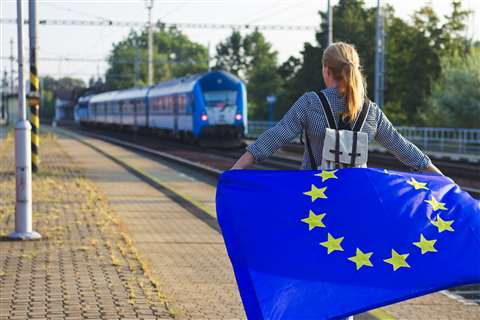 Rail Baltica plays a siginificant role within EU strategy. Photo: Adobe Stock
Rail Baltica plays a siginificant role within EU strategy. Photo: Adobe Stock
“Russia’s aggressive war in Ukraine, despite its financial and commercial implications to the region, has demonstrated once again how important it is to see Rail Baltica as a geopolitical security project,” Roberts Zile, vice president of the European parliament and a former Latvian finance minister told the Friends of Rail Baltica group at the European Parliament in April. “Military mobility allocation, as a necessary part of the funding, is no longer discreetly glossed over, as in the past.”
“Rail Baltica is not just a priority – it is an obligation,” added French MEP Catherine Trautmann “The Baltics have to be connected to the rest of Europe by all forms of transport. There are plane connections, there are road connections, but rail connections are not what they need to be.”
The mega project, the largest infrastructure project in the Baltic region in a century, aims to connect Tallinn, Riga and Vilnius - the respective capital cities of Estonia, Latvia and Lithuania - both to each other and to the Polish capital, Warsaw (and potentially the Finnish capital Helsinki) via a European standard 1435mm electrified gauge line. This will end the current situation, in which the three states’ only rail link is via a 1,520mm Russian gauge track to Moscow and St Petersburg.
Comprising seven international passenger stations, three freight terminals, more than 400 new bridge structures and 25 km of major structures, the project is certainly ambitious.
 Rail Baltica Management Structure. Source: Rail Baltica
Rail Baltica Management Structure. Source: Rail Baltica
Yet, despite renewed European enthusiasm, it has been dogged on all sides by issues including spiralling costs, arguments about the route, squabbles between the three states (even the name is in dispute with the railway known as ‘Rail Baltic’ in Estonia) and the technical difficulties associated with constructing a greenfield railway across four international borders - including some areas which are literally minefields.
Rail Baltica hit by delays
Arguments between the three states and the EU about finding the €5.8 billion which accountants EY estimated the construction costs of the mega project to be in 2017, have also hampered progress and more recently the Covid pandemic has been blamed for further delays. In 2020, the European Court of Auditors warned that the project was unlikely to meet its 2026 construction deadline and was likely to exceed its budget - costing around €7bn to build.
The three Baltic states agreed in 2014 to form a joint venture company, RB Rail AS, to be in charge of design, construction and marketing the railway, although each state also has its own body charged with implementing the project.
Latvian structural and software engineer Raitis Bušmanis is head of RB Rail AS’s virtual design and construction department. He sits at the sharp end of this complex arrangement, helping to coordinate the vast project by liaising with construction companies, designers, government agencies, municipalities, national implementing institutions, the public and others.
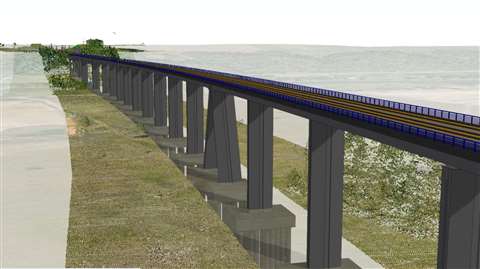 A BIM model of the longest bridge in the Baltic states to be built over the River Neris in Lithuania as part of the project. Image: Rail Baltica
A BIM model of the longest bridge in the Baltic states to be built over the River Neris in Lithuania as part of the project. Image: Rail Baltica
One of the most important tools RB Rail is using to achieve this, he says, is geographic information system (GIS) mapping software which enables the team to keep tabs on everything that is going on with the project through a detailed geographical representation, delivering what is known as a single source of truth.
“Nowadays GIS is not just a number of layers visualising information on the map, but a database making it possible to work also with attribute information,” he says. “Rail Baltica is location based - everything in this project in one way or another has a location. That means that the geographical representation of the project is especially important if we want to see the whole picture, even more from a cross-border perspective. It helps us to choose the best technical and design solutions.”
To do this, RB Rail has struck a deal with mapping and special analytics company Esri to provide a number of products and licenses including its Esri ArcGIS mapping system which can be used to mastermind planning and delivery.
Even though the size and complexity of the rail project means that it has to be split up into more manageable sections, the GIS enables the team to gather data from each of them into one place.
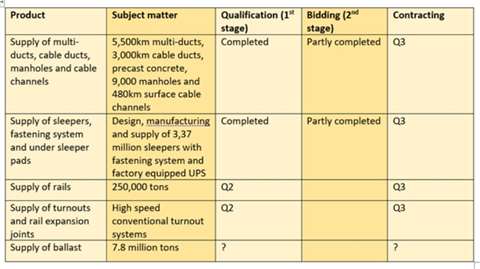 Rail Baltica consolidated materials supply procurements planned for this year. Source: Rail Baltica
Rail Baltica consolidated materials supply procurements planned for this year. Source: Rail Baltica
GIS system benefits
Bušmanis says the universal technology enables his team to integrate the various different data formats used by all the different contractors working on the project and quickly and easily share information.
“The system must be ready to serve many different users with different needs,” he says. “These include different licenses, different types of users, different applications and different tools.”
One of the most important uses of the GIS system is as a place to coordinate the BIM (building information modelling) models, which RB Rail has made a central part of its design and construction plans. All companies tendering to undertake construction work on Rail Baltica are required to use BIM and the project follows IFC (industry foundation classes) standards, so that computer files remain interoperable - no matter what software they use.
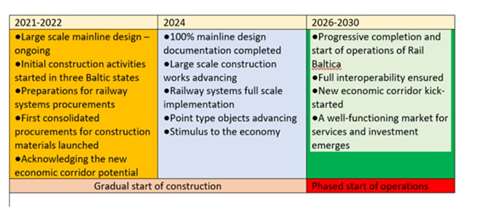 Rail Baltica construction timeline. Source: Rail Baltica
Rail Baltica construction timeline. Source: Rail Baltica
“In our project, GIS is a central environment where other systems “meet” with each other, so BIM models are used in the GIS environment,” Bušmanis says. “It means that BIM models are incorporated into the GIS and we can enrich BIM with additional data. So, our asset register is built on ArcGIS solution and the information about the asset data comes from BIM model attributes.”
Rather than relying on site reports from project managers from across the three countries and 870km of track, RB Rail plans to incorporate up-to-date information on progress by uploading information from weekly drone flights as well as photographs from mobile phones from teams in the field.
The drones, which are already in operation, flying over Rail Baltica’s first major construction sites at Riga Central Station and Riga International Airport, use orthophoto technology which geometrically corrects each photograph to display it in a uniform scale and LiDAR (light detecting and ranging) remote sensing technology which sends laser pulses to the Earth’s surface and records the data through a collection of points known as Point Cloud.
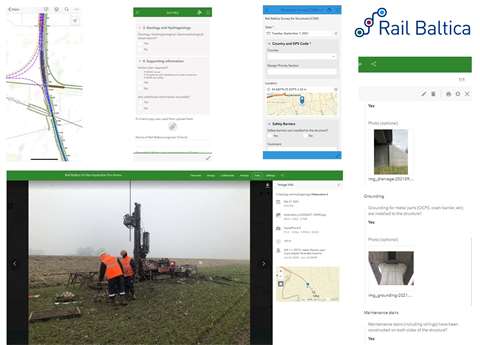 The Rail Baltica GIS system incorporates field data. Image: Rail Baltica
The Rail Baltica GIS system incorporates field data. Image: Rail Baltica
The technology enables the team to examine both natural and manmade environments to a level of accuracy which would not otherwise be possible. RB Rail engineers then use all of this information as a basis for the railway’s design, construction and operation.
“Our hope is that office-based staff will be able to track the progress of construction works without going to the site – to open the laser scan or photogrammetry or as build data and see it their screens,” Bušmanis says.
The resulting data map, he says, will be used to help engineers and other professionals across the project with everything from land acquisition planning and representing geotechnical investigation results, to calculating volumes, noise model mapping, hydrology mapping, managing warranty issues and even public engagement.
By allowing engineers to link geographic data with schedules for future works, they will be able to use the system to understand how the project will evolve from both a time and geographic perspective.
“GIS enables us to verify and validate the information on global level,” Bušmanis says. “For example, to make sure that all piles have the same Uniclass 2015 code attached, or we can also find all manholes of certain type and plan the construction logistics when the manholes are procured centrally.”
Construction begins on major section of track
And, as Rail Baltica continues to move from its design phase to construction, Bušmanis says these sorts of features will become more useful to whichever body is finally chosen to run and operate the railway once it has been completed.
Work on the line’s first viaduct, in Saustinõmme, Estonia, started in November 2019, undertaken by Finnish construction company YIT. And work began on site in 2021 at two of the most high-profile sites in Latvia - Riga International Airport and Riga Central Station – undertaken by some the biggest names in European construction including Besix of Belgium, Swietelsky of Austria, Egis Group of France and Deutsche Bahn of Germany.
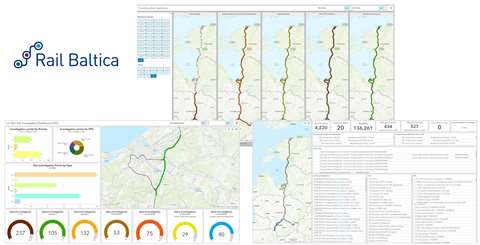 RB Rail’s GIS system can be used for scheduling and reporting. Image: Rail Baltica
RB Rail’s GIS system can be used for scheduling and reporting. Image: Rail Baltica
And in April 2022, Rail Baltica announced that construction had started on the first major section of track, running from Kaunus in Lithuania to the Latvian border through construction company Eurovia Lieutuva, starting with work on 16 access roads.
“Because we have such complex and diverse needs, it’s difficult to predict exactly what our GIS needs will be in the long run,” says Bušmanis. “We believe that collecting the design and construction data during these early stages will have a huge benefit during the operations and maintenance phase - we collect data gradually, so that the hand over will be more efficient and cost effective.”
Some of the biggest Rail Baltica contracts:
| Rail Baltica Project | Partner | Works involved | Progress |
| Entire line: Control command, signalling and engineering works supervision | Systra (France), Ferrovie dello Stato (Italy) and Egis (France) | Providing engineering and project management services for preparation, procurement and supervision of control-command and signalling subsystems | Contract awarded January 2022 |
| Central Hub, Riga, Latvia |
Design - Danish architects PLH and Cowi Construction - Bererix – a joint venture between Belgium’s Besix and Latvia-based Sia Rere BÅ |
Reconstruction of the Riga railway station complex, construction of a railway bridge across the river Daugava and installation of European standard gauge tracks | Design contact awarded in 2017. Construction contract awarded in 2019. Construction started in November 2020 |
|
Riga International Airport Railway Station, Riga, Latvia |
Design contract: One Works (UK) Construction design and supervision: PROSIV – Sintagma (Italy), Prodex (Slovakia) and Vektors T (Latvia) Construction: BSL Infra – Swietelsky (Austria), SIA Binders (Latvia), AS LNK Industries (Latvia) |
The project includes extending Rail Baltica infrastructure from Imanta railway station to the airport and constructing a new terminal |
Design contract awarded in 2019. Construction contract awarded in March 2021. Construction started in July 2021 and will continue until December 2025 in five phases |
| Tallinn passenger terminal, Estonia | Design awarded to Zaha Hadid Architects (UK) and Esplan (Estonia) | New railway terminal at Ülemiste, located close to Tallinn airport and will become a multimodal hub | Design competition held in 2019. Construction contract is expected to be signed in 2022 |
| Vilnius Railway station and surrounding area, Lithuania | Design awarded to Zaha Hadid Architects | Plans will renovate Vilnius railway station and create a 9,500 sq m concourse bridge | Design competition awarded in September 2021 |
| Estnia main line section | Design and supervision contract: Obermeyer Planen + Beraten (Germany) and Prointec (Spain) | Design and supervision services for 93.5km high speed rail section from Pärnu to the Latvian border | Contract awarded in February 2020 |
| Latvia North railway section | Supervision and design: INECO and Ardanuy Ingeniería (Spain) | 94km railway connecting Vangaži with the Estonian border | Design contract awarded April 2020 |
| Muuga freight station Estonia |
Design contract: Sweco (Sweden) |
Freight station buildings and connections including 35km of new 1435 gauge railway and relocating 11km of existing 1520mm gauge track | Design contract awarded 2020. Construction to begin in 2022 and to be completed by 2025 |
STAY CONNECTED



Receive the information you need when you need it through our world-leading magazines, newsletters and daily briefings.
CONNECT WITH THE TEAM









